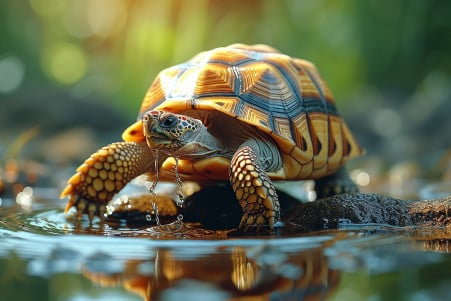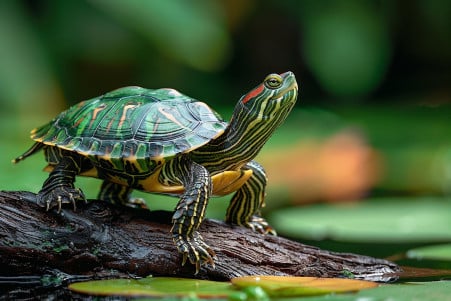The Complex Mating Behaviors of Tortoises: An In-Depth Look
16 May 2024 • Updated 15 May 2024

Tortoises may be slow and plodding, but their mating behaviors are anything but. From pursuit to courtship displays to reproductive tactics, tortoises have evolved a wide range of mating behaviors that are anything but simple. Male tortoises pursue females with head bobbing, ramming, and even vocalizations, and have been observed traveling great distances to find a mate during the breeding season. Mating itself involves the male mounting the female from behind and inserting his penis into her cloaca.
With their long lifespans and late age of sexual maturity, this article will delve into the latest research on the mating behaviors of different tortoise species, which have evolved over millions of years. From elaborate courtship displays to the biological marvels that make fertilization possible, this article will take a deep dive into the mating behaviors of tortoises to reveal the incredible evolutionary adaptations that have occurred in these long-lived reptiles. Drawing on scientific research and first-hand observations, you will come away with a deeper understanding of the complex biological processes and mating behaviors of a range of tortoise species.
How do tortoises mate?
Courtship Displays and Pursuit Behaviors
Courtship displays and pursuit behaviors are an important part of the mating system of tortoises. Male tortoises use aggressive behaviors to attract females and deter competitors, and these behaviors can include head bobbing, circling, ramming, and biting. Some tortoise species also use vocalizations, such as grunts or squeals, during courtship. The intensity and type of behaviors involved in courtship can differ between species of tortoises, and this variation is often related to differences in body size and habitat preference.
For example, a study of European tortoises found that smaller species, such as the Marginated Tortoise, relied more on aggressive displays during courtship than larger species, such as the Hermann's Tortoise, which relied more on acoustic signals. This difference is believed to be an adaptation to the denser vegetation preferred by smaller tortoise species.
In addition, environmental conditions can also impact courtship behaviors, with temperature and rainfall affecting the level of courtship activity. For example, studies of leopard tortoises have shown that they exhibit greater movement and have larger home ranges when resources, such as food and water, are scarce, and this is likely to increase the likelihood of encountering mates during the breeding season. Therefore, the aggressive pursuit and elaborate courtship displays of male tortoises are important in attracting females and securing mating opportunities in an environment that is often resource-poor.
How Do Tortoises Mate?
After the elaborate courtship rituals, the male tortoise mates with the female by mounting her from behind. The male's longer tail and concave plastron, or underside shell, make it easier for him to mount and copulate with the female. Per Pets on Mom.com, the mature male's curved carapace (upper shell) also enables him to easily mount the female, whose plastron is flatter and carapace flares outward to accommodate mating.
During mating, the male may copulate multiple times and will often stamp his hind feet forcefully. It's worth noting that female tortoises can store sperm in their cloaca for long periods of time, up to 4 years in some species. A study in the Journal of Heredity suggests that this sperm storage allows females to fertilize their eggs over several breeding seasons without additional copulations. This way, females can exert more influence over the reproductive success and genetic diversity of their offspring.
Egg Incubation and Hatchling Survival
Following mating, female tortoises will dig a nest and lay a clutch of eggs, which usually consists of 4-7 eggs. The incubation period can be highly variable based on species and environmental factors, and can last anywhere from 80 to 175 days according to the California Turtle & Tortoise Club. The right temperature and humidity levels are essential for successful incubation and the health of the hatchlings. The Tortoise Trust suggests that most tortoise species should be incubated at temperatures between 29-32°C, with humidity levels between 70-80%.
Hatchling survival can be influenced by a number of factors, including the location of the nest, predation, and the weather. A recent study published in Scientific Reports even suggested that fungal infections, climate change, and human activities are the biggest threats to the survival of sea turtle hatchlings. To combat these threats, many conservation programs focus on protecting nesting sites and artificially incubating eggs. By learning more about the specifics of tortoise egg incubation and hatchling survival, we can help ensure the continued success of these incredible animals.
Differences and Specializations Between Species
The mating behaviors and reproductive strategies of tortoises are incredibly diverse between species. For example, in a study of European tortoise species, differences in courtship displays were often found to be related to body size and the structure of the species' habitat. Smaller species like the Marginated Tortoise were more likely to use aggressive displays, while larger species like the Hermann's Tortoise were more likely to use acoustic signals - an adaptation to the density of the vegetation they prefer.
In addition, some tortoise species exhibit seasonal migrations or elevational movements that are related to reproduction. For example, research on Galapagos giant tortoises has shown that larger tortoises are more likely to migrate to higher elevations during the wet season when the new vegetation is more digestible. Meanwhile, environmental factors like temperature and rainfall can also have a big impact on reproductive success, as shown in a study of Galapagos giant tortoises. It's important to maintain connections between important foraging and breeding habitats to ensure the long-term survival of tortoises.
Conservation Challenges and Efforts
Over half of all tortoise species are at risk of extinction, according to the World Conservation Society. The most significant threats to tortoises are habitat destruction, hunting, invasive species, and climate change. Mongabay reports that habitat loss is the most significant threat to turtles and tortoises worldwide, followed by the pet trade, overharvest, pollution, and invasive species.
Habitat preservation and the creation of reserves are important for protecting the tortoises that remain. The Galapagos Conservancy has worked to restore giant tortoise populations in the Galapagos Islands, using methods such as captive breeding and reintroduction. Community involvement and collaboration have been important components of their work.
Although some species, such as sea turtles, have made comebacks, more than a third of turtle and tortoise species are at risk of extinction. It will take a combination of conservation measures, from habitat preservation to captive breeding, to ensure that these fascinating animals continue to exist for generations to come.
Conclusion: The Fascinating Mating Habits of Tortoises
The mating habits and courtship behaviors of tortoises have been shaped by millions of years of evolution. The ability to reproduce is dependent on anatomical adaptations and environmental factors. The wide range of mating behaviors seen across tortoise species is a result of their adaptations to different habitats and ecological niches.
Conservation is important to save tortoises that are currently at risk of extinction and the habitats they live in. With more than half of all tortoise species at risk of extinction, it is important to understand their mating and reproductive behaviors to ensure that these fascinating reptiles will be around for many years to come.


